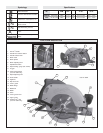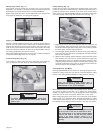
page 9
4. If making a partial cut, restarting in mid-cut or correcting direction,
allow the blade to come to a complete stop. To resume cutting, center
the blade in the kerf, back the saw away from cutting edge a few
inches, pull the trigger and re-enter the cut slowly.
5. If the saw binds and stalls, maintain a firm grip and release the trigger
immediately. Hold the saw motionless in the workpiece until the blade
comes to a complete stop.
6. After finishing a cut, be sure the lower guard closes and the blade
comes to a complete stop before setting the saw down.
Electric Brake (Cat. No. 6394)
Select models feature an electronic brake. The brake engages when the
trigger is released, causing the blade to stop and allowing you to pro-
ceed with your work. Generally, the saw blade stops within two sec-
onds. However, there may be a delay between the time you release the
trigger and when the brake engages. Occasionally the brake may miss
completely. If the brake misses frequently, the saw needs servicing by
an authorized MILWAUKEE service facility. The brake is not a substitute
for the guard, and you must always wait for the blade to stop completely
before removing the saw from the workpiece. The correct brush grade
must be used for proper operation of the brake. Use only the correct
MILWAUKEE replacement brushes when servicing the tool.
Troubleshooting
If the blade does not follow a straight line:
• Teeth are dull. This is caused by hitting a hard object such as a nail or
stone, dulling teeth on one side. The blade tends to cut to the side with
the sharpest teeth.
• Shoe is out of line or bent
• Blade is bent
• Rip fence or guide is not being used
If the blade binds, smokes or turns blue from friction:
• Blade is dull
• Blade is on backwards
• Blade is bent
• Blade is dirty
• Workpiece is not properly supported
• Incorrect blade is being used
APPLICATIONS
Selecting Tilt-Lok™ Handle Positions (Figs. 14, 15 & 16)
The Tilt-Lok™ handle is a feature which allows the user to adjust the
angle of the handle for optimum cutting positions. The Tilt-Lok™ handle
has eight (8) detents which allow the handle to snap into position
(Fig. 14). See “Adjusting Tilt-Lok™ Handle” for instuctions on adjusting
the handle. Refer to the chart below for suggested handle positions.
WARNING!
To reduce the risk of injury, wear safety goggles
or glasses with side shields. Unplug the tool
before changing accessories or making
adjustments.
APPLICATION SUGGESTED TILT-LOK POSITIONS*
For cuts made at or near
waist level
Handle in lower positions (Fig. 15)
allows for more leverage when push-
ing the saw through the workpiece.
For shallow cuts made at
or near waist level
Handle in lower positions allows the
user to apply increased downward
force during shallow cuts.
For cuts made below the
waist, as in flooring appli-
cations
Handle in higher positions (Fig. 16) re-
duce the amount of “bending over” by
the user. Higher handle positions allow
the user to apply an increased
downward force on the saw.
For cuts made overhead,
as in ceiling applications
Handle in higher positions reduce the
amount of extended reach by the user
for overhead cuts. Higher handle posi-
tions allow the user to apply an
increased upward force on the saw.
* These are only suggested positions; the actual optimum cutting posi-
tion may vary depending on the actual application and user preference.
Fig. 15
Fig. 16
Fig. 14


















